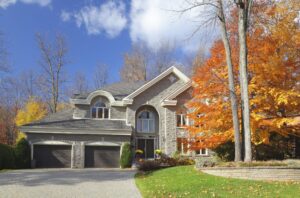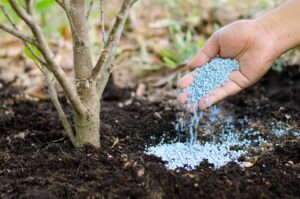Trees are great, aren’t they? It’s not a controversial statement. They provide shade, oxygen, a place to climb or hand a hammock or swing, food, and the inspiration for classic children’s literature!
Both Dr. Suess’s The Lorax and Shel Silverstein’s The Giving Tree address our rather one-sided relationship with trees (and more metaphorically), so following in the footsteps of those great authors, Divine now asks: What are You doing for your trees?
Tree Root Fertilizer would be a good start.
Trees and Cooperation
There’s growing evidence that trees live in a community. Some have even described trees in a forest as “communicating” with one another, although that particular descriptor is controversial.
We know that trees are aware of each other and share resources at a certain level. And that makes sense when you think about how in their natural habitat, they live close together.
In a forest, trees have found a way to survive around each other and the many other forest inhabitants, plus all the debris that they create. All the leaves that fall from trees and other plants make a natural mulch for the trees while also fertilizing the soil as they break down. The little animals living in and around the trees also add fertilizer to the mix.
It’s natural symbiosis at its finest.
Modern Landscaping
So, here we are in our modern homes with our modern, gorgeously landscaped yards with a lush, thick green carpet of lawn, ornate flower beds, a few shrubs, and a tree or two out of their islands of mulch. Lovely for humans, but you can see how that’s a bit different than the environment in which trees evolved.
Trees don’t have the same relationships with the land they have in the forest. And because there isn’t the same biodiversity as in the woods, the trees aren’t getting the same nutrients from other plants as they break down or animals as they travel among the trees.
Modern landscaping prevents biodiversity. We try to keep animals away because they can be dangerous to human health and many plants away because they are detrimental to our homes.
A Lesson From Farming
There’s a farming practice known as crop rotation. It involves planting different crops on the same land. Once one crop has finished producing, farmers introduce a new complementary crop.
Crop rotation aims to emulate what forests do naturally – enrich the soil. Different crops need different nutrients and produce other nutrients as byproducts.
As farming industrialized, crop rotation became less common (although organic farmers and gardeners still use the practice.) As a result, plants used up all the nutrients over one or two seasons, depleting the soil. So another strategy was needed – fertilization.
Amending the Soil
Numerous fertilizers amend the soil for gardeners and farmers. And just like farmers’ crops, over time, trees also deplete the nutrients in the ground and need to have their soil amended. That’s why Divine offers tree root fertilization as one of our tree services.
Tree Root Fertilizer
Tree root fertilizer is used to feed your trees the food they need. Because trees don’t have the same natural access to food in the modern home, we need to do our part to feed them.
A Quick Correction
We’re using food as shorthand. In reality, tree root fertilization provides the ingredients for the trees to make their own food for photosynthesis. Perhaps a more accurate metaphor is that we are delivering groceries so the trees can make dinner, but when’s the last time you said you were going to the store to buy “ingredients”? We say food.
How Do You Know Your Trees Need Fertilizer?
Some landscapes are better suited for feeding trees than others. So, your trees may or may not need tree root fertilizer. So how do you know?
Contacting a professional like Divine can answer the question for you. We check for signs that trees need fertilizer. Trees will exhibit symptoms of malnourishment, such as discolored leaves.
In addition, soil testing can answer what the ph of the soil is and what nutrients the soil lacks, giving excellent guidance on what and whether to fertilize.
Fertile Ground for Your Trees
Tree root fertilizer is something that most homeowners don’t know a whole lot about. Fertilizing incorrectly can cause damage. The wrong fertilization can cause more harm than good.
We always recommend professional help for your fertilizer and other landscaping needs. If you have questions, please reach out to Divine!
 (316) 435-3509
(316) 435-3509 office@divine-lawns.com
office@divine-lawns.com
